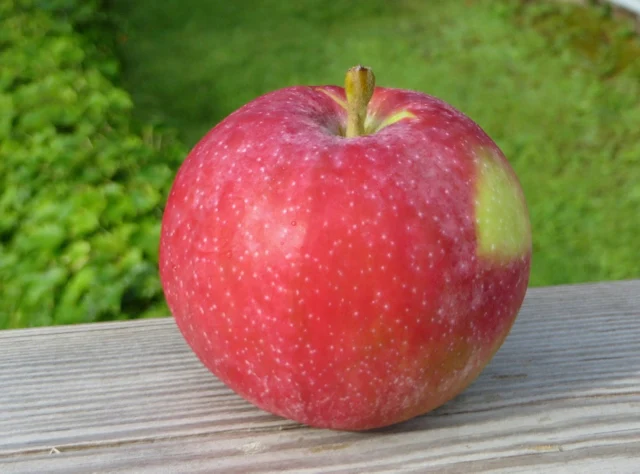
|
When I started this blog, I had the notion that this apple was not a real variety. That the name was just a generic catchall for any number of different early apples.
Not so, of course: Early McIntosh has a first-rate pedigree, with McIntosh himself providing the parenting pollen and Yellow Transparent the seed.
Though I figured that out a while ago, this is my first bite.
Early McIntosh (popularly, Early Mac) has a general Mac-like appearance:
round, faintly ribbed, with a red blush decorated with streaks and light
lenticels.
There's even a little bit of a whitish bloom. The underlying color is spring green.
Early's blush is a little more orange than a real McIntosh, the ribbing less.
Bite bite
Early's yielding fine-grained white flesh has a little crunch and some very nice flavors.The fruit is slightly vinous, as befits a child of McIntosh, but also has some of the flavor that I, for lack of a better, call “cider.” It gives this apple a nice fruity roundedness and strikes a later-season note.
It's well balanced and sweeter than a Mac. The peel is chewy and tough, and the finish is quite pleasant.
Not as good as Williams Pride, which it somewhat resembles in taste, and also not very Mac like. But a pleasure in August.
Early Mac was developed in 1909 by Richard Wellington of the Ag Station at Cornell. It was introduced in the 1920s.
Links
- Yellow Transparent x McIntosh
- Williams Pride
- Bulliten No. 514 of the New York State Agricultural Experiment Station, Feb. 1924, pages 4–5
- Cider (as a flavor)
- Richard Wellington memorial


There's also a Ukrainian apple cultivar called Slava peremozhtsiam
ReplyDelete(original orthography: Слава переможцям; Russian translation: Слава победителям; English translation: Glory to the Winners).
And it appears to be a full sibling of the Early McIntosh (Yellow Transparent x McIntosh).
Some USDA data, for curiosity:
* Early McIntosh
* Slava Pobeditelyam